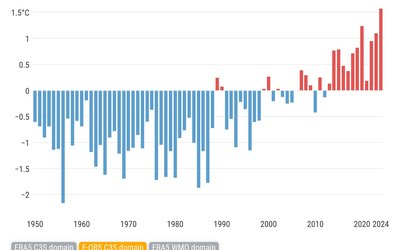
Past climate changes
In the period 1951–2010, a statistically significant increase in the mean annual temperature of 0.07–0.22°C per decade is present along the Croatian coastal zone. This increase is further amplified within recent shorter periods. For example, in the period (1981–2010), it ranges from 0.28 to 0.71°C per decade. Five to seven out of ten warmest years since the middle of the twentieth century were recorded in the most recent decade 2001–2010. Temperature trends are positive in all seasons. In the first decade of the twenty-first century, they are statistically significant at the 0.05 level for summer (0.19°C/10 years to 0.38°C/10 years) and spring (0.12°C/10 years to 0.29°C/10 years), but positive trends for winter and autumn are comparably weak.
Along the Croatian coastal zone interannual variability of annual precipitation during the period 1951–2010 is large and there are practically no significant trends in either annual or seasonal precipitation amounts for the different parts of the country.
Future climate changes
Climate change projections have been made for the future 30-year periods 2011–2040, 2041–2070 and 2071–2100, and compared with the period 1961–1990. This has been done for five different RCMs, driven by one GCM, and based on the IPCC SRES A1B scenario.
The mean annual trend of projected future warming for the period 2011–2100 is between 0.3 and 0.5°C per decade. The results show a statistically significant warming in the eastern Adriatic region in all three 30-year periods of the twenty-first century. The largest temperature increase is projected for the summer and early autumn, gradually rising from +2°C in the near future to +5.5°C towards the end of the twenty-first century, respectively.
In the first half of this century, projected precipitation change is uncertain. In the second half of this century a reduction of precipitation in the warmer part of the year (April – August/September) prevails and an increase of precipitation from December to February (March) prevails. These projected changes are statistically significant at only a few of the studied locations in the country, however.
Source: Branković et al., 2013. Climate Dynamics 41: 2353–2373.
Photo: Mike McHolm (www.flickr.com)








